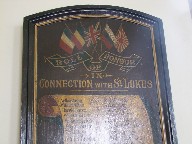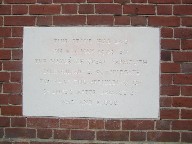| |
|
St Luke,
Cobholm, Great Yarmouth
 |
|
This
may well be the least-known, and least visited,
Anglican church in Norfolk. It is tucked away in
the terraced streets of Cobholm Island, the
northern part of the Great Yarmouth suburb of
Southtown, near to where Breydon Water funnels
itself through the town and out to sea. By any
index, Cobholm is one of the most economically
and socially deprived areas in England. Although
inextricably linked with Southtown, it was
historically in a separate parish. Southtown was
a part of the parish of Gorleston, whilst Cobholm
was part of Great Yarmouth St Nicholas. Despite
this, Cobholm was in Suffolk until the 1920s. The church
of St Luke was opened as a parish of ease to St
Nicholas in 1908, a fact which is attested to by
the foundation stone at the west end, but which
is rather hard to believe when you look at the
building. This is of course because of the two
major 20th Century events in the history of Great
Yarmouth, the German bombing blitz of 1941 and
the floods of 1953, both of which caused serious
damage. In proportion, the Borough of Great
Yarmouth lost more of its buildings in the blitz
than any other town in England.
|
And then,
it lost another 3,500 houses on the night of 31st January
1953, when the great North Sea came raging up the river
mouth. Most of these were in the lowlying Southtown and
Cobholm areas. Remarkably, only ten people were killed
that night, a fraction of those who lost their lives
further south in Felixstowe, Jaywick and Canvey Island.
Perhaps the people of Cobholm and Southtown were simply
more used to adversity.
The 1908
church which was lost was a fine half-timbered structure
very much in the Edwardian style. It had a large square
bell turret, and small transepts to the chancel, which
presumably contained the organ and the vestry. To see
what it looked like, there is a photograph hanging inside
the church. Or, alternatively, cross over the river to St Paul in Newtown, which
was built ten years earlier and was almost identical
before the addition of the south aisle. The architects
there were Bottle & Olley, so they probably were here
as well. The rebuilt church of 1960 was completely in
brick, with an identical bell turret but without the
transepts. The overall plan is very similar, but the
style is very functional, more like a hall than the
pretty little church which stood here before.
| Having
said that, you step inside to a warm, beautifully
kept interior, which retains something of the
Anglo-catholic atmosphere which must once have
been prevalent. All around, there is a sense of
the pride this community keeps in its church, the
finely crafted banners, the shining brass, the
smell of polish. Every good parish church is
a touchstone to the long generations of its
community, and although there has been a church
here for barely a century, it is certainly true
of St Luke. The simple war memorial, In
Memory of Our Fallen, contains no less than
forty names, and there is also a beautifully
painted Roll of Honour, one of the best of its
kind I have seen in East Anglia. A separate
memorial remembers Walter John Castell, a Private
in the 7th Batallion of the Norfolk Regiment, who
was killed in the Battle of Ypres in May 1917. It
recalls that he was for 5 years
Superintendent of the Infant School. Another
poignant memorial is a display case to Jimmy
and Fred Wright, two very good footballers.
Tragically killed by enemy action 18th April
1941.
|
|
 |
|
|
|
